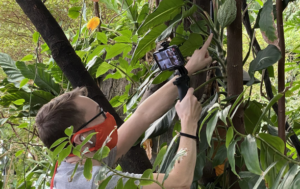I’m an interactive designer at the Smithsonian. We’re often referenced as “the Nation’s Attic,” but I don’t think that metaphor fits. An attic is a place of forgetting; we’re more like the dinner table of a big, boisterous family that mixes both stories of key moments in our past with very dynamic tales of what is happening now or thoughts of the future. Your great-grandmother is there, telling stories about the Great Depression. Your quirky uncle that won’t stop regaling you with stories about the marvels of a very specific species of slug is also there. I guess I’m the kid at the end of the table with spaghetti all over his face and a Gameboy hidden under the table, engrossed in a whole different realm.

Our objects are touchstones to a body of knowledge that we’ve built together over the last 175 years and continue to build in real-time for the future. As a Smithsonian educator, I am one of a community of over 300 staff that focus on supporting schools and families across the country. We are the front line for diffusing this body of knowledge. The superpower of our educators is to take those stories — the content, the objects, the resources, the research — and package it all up in a way that’s accessible, engaging and fun for a variety of audiences and ages: students on field trips, families on walking tours, lesson plans for classrooms, teacher trainings and activity guides delivered across the country.
As educators turn their attention to the new school year, I’d like to share 12 carefully crafted examples designed to inspire and empower educators. Each resource is paired with a session from our recent 2023 Smithsonian National Education Summit. Get ready to load up your teacher toolkit with these K-12 interdisciplinary resources!
“Thank you so much for hosting these discussions. It feeds me both as a scientist and as a teacher.” 4th-6th grade science educator
1. Secrets of the Sea online game (Grades 3-6)
In this online interactive game based on the work of renowned marine biologist and author Nancy Knowlton, you’ll navigate the hidden treasures of a coral reef. From the tiniest plants to the largest hunters, discover the connections between the creatures in a coral reef. Recreate a healthy ecosystem by finding living things and returning them to the coral reef.
If you like playing this game, check out the Summit session “Bringing the Science of Climate Change to the Classroom.”

2. Environmental Justice! research guide (Grades 6-8)
This community research guide, developed by the Smithsonian Science Education Center in collaboration with the InterAcademy Partnership, helps young people learn more about the concerns of their community in order to communicate accurate, helpful and trusted information about environmental justice.
If you like this guide, check out the Summit session “Partnering with Youth for Sustainability.”

3. Conservation Classroom (Grades K-5)
Conservation Classroom is a collection of monthly lessons from the Smithsonian’s National Zoo and Conservation Biology Institute. Each lesson has four elements: wonder, engage, act and connect. In addition, educator’s materials help implement the lesson in the classroom.
If you like this guide, check out the Summit session “Design as a Tool for Student Sustainability Leadership.”

4. Sustainability in Action activity guide (Grades 9-12, post-secondary/adult)
This 12-page guide curated by a team of educators across the Smithsonian is filled with success stories in conservation highlighting leading research currently underway and featuring ways that generations across the country can contribute to Our Shared Future: Life on a Sustainable Planet.
If you like this guide, check out the Summit session “Sustainability is Everyone’s Business.”

5. “Deconstructing Power: W. E. B. Du Bois at the 1900 World’s Fair” (Grades 8-12)
This online exhibition places decorative arts from Cooper Hewitt’s permanent collection in dialogue with 20 innovative data visualizations that W. E. B. Du Bois (1868-1963) created for the 1900 Paris World’s Fair to explore how design can both reveal and mask dynamics of power and equity.
If you like this exhibition, check out the Summit session “Deconstructing Power: Using Data in the Classroom.”

6. Get To Know Mark Bradford (Grades pre-K-5)
This collection is a part of the Hirshhorn KIDS “About the Artist” series, designed for kids under age 12. Sharing these life stories and artworks can help kids see their own potential and better understand the world and their place in it.
If you like this collection, check out the Summit session “History Is Messy: How We Tell and Remember Stories.”

7. Social-emotional learning toolkit (Grades 4-9)
This toolkit, created by the Smithsonian American Art Museum and tested by educators across the US and two Washington, D.C.-based art therapists, can help you regulate your emotions, identify supportive connections and speak your mind.
If you like this toolkit, check out the Summit keynote “Belonging Fuels Motivation & Learning.”

8. Smithsonian early learning resources (Grades pre-K-2)
The resources on this page, curated by the Smithsonian Early Learning Collaborative, teach children active observation and questioning skills that will help students stay curious and become critical thinkers and creative problem-solvers.
If you like these resources, check out the Summit session “Promoting Historical Thinking Skills in Young Learners.”

9. Reckoning With Our Racial Past: Framing Systemic Racism (Grades 8-12)
Understanding the past is the key to building a better shared future, but where do we begin? This new educational series of videos, created in partnership with Google Arts & Culture, illuminates how systemic racism shows up in our lives and offers a resource for educators and all audiences to recognize how we might change it.
If you like these videos, check out the Summit session “Towards a More Equitable Future.”

10. Smithsonian Summer Sessions: Interrogating the Stories We Tell (Teacher training)
In this edX course, educators from six Smithsonian museums dive deeply into the objects in their collections to interrogate the stories we know and tell our students. They explore connections among their collections and model teaching strategies that participants can implement with their students.
If you like this course, check out the Summit session “Inspire Creative Changemakers.”

11. “Americans” dialogue toolkit (Educator resource, grades 4-12)
This toolkit by the National Museum of the American Indian provides basic grounding in the practice of dialogue and includes three 60-minute models that educators can use in connection with the “Americans” exhibition. Use this toolkit to facilitate new conversations with and among students about the power of images and words, the challenges of memory and the relationship between personal and national values.
If you like this toolkit, check out the Summit session “Teaching American History from a Native Lens.”

12. Expanding Roles of Women curriculum guide (Educator resource, grades 6-12)
This interdisciplinary curriculum guide by the National Portrait Gallery uses portraits as entry points to teach about the history of women in the US from the Colonial period to the dawn of the 20th century. By studying these works of art, students will come to understand how the women portrayed located agency. Furthermore, students will reflect on the present by considering how women today continue to bring about societal change.
If you like this toolkit, check out the Summit session “Sharing Stories of Women in STEAM Careers” or the archived walkthrough of this curriculum guide.
Our Summit theme was Together We Thrive, inspired by the science of learning and development’s growing body of research, which emphasizes that every student has the potential to thrive in all disciplines when provided with the right circumstances, contexts and support. It is our goal to not only reach every classroom in the country but also to offer the essential support needed for all learners to thrive.
Cody Coltharp is an interactive designer in the Office of the Under Secretary for Education for the Smithsonian Institution and works with museum scientists, researchers and educators. Coltharp develops games, graphics and simulations using Smithsonian digital resources to make the research, data and stories more accessible and engaging.
Opinions expressed by SmartBrief contributors are their own.
_________________________
Subscribe to SmartBrief’s FREE email newsletter to see the latest hot topics on EdTech. It’s among SmartBrief’s more than 250 industry-focused newsletters.
